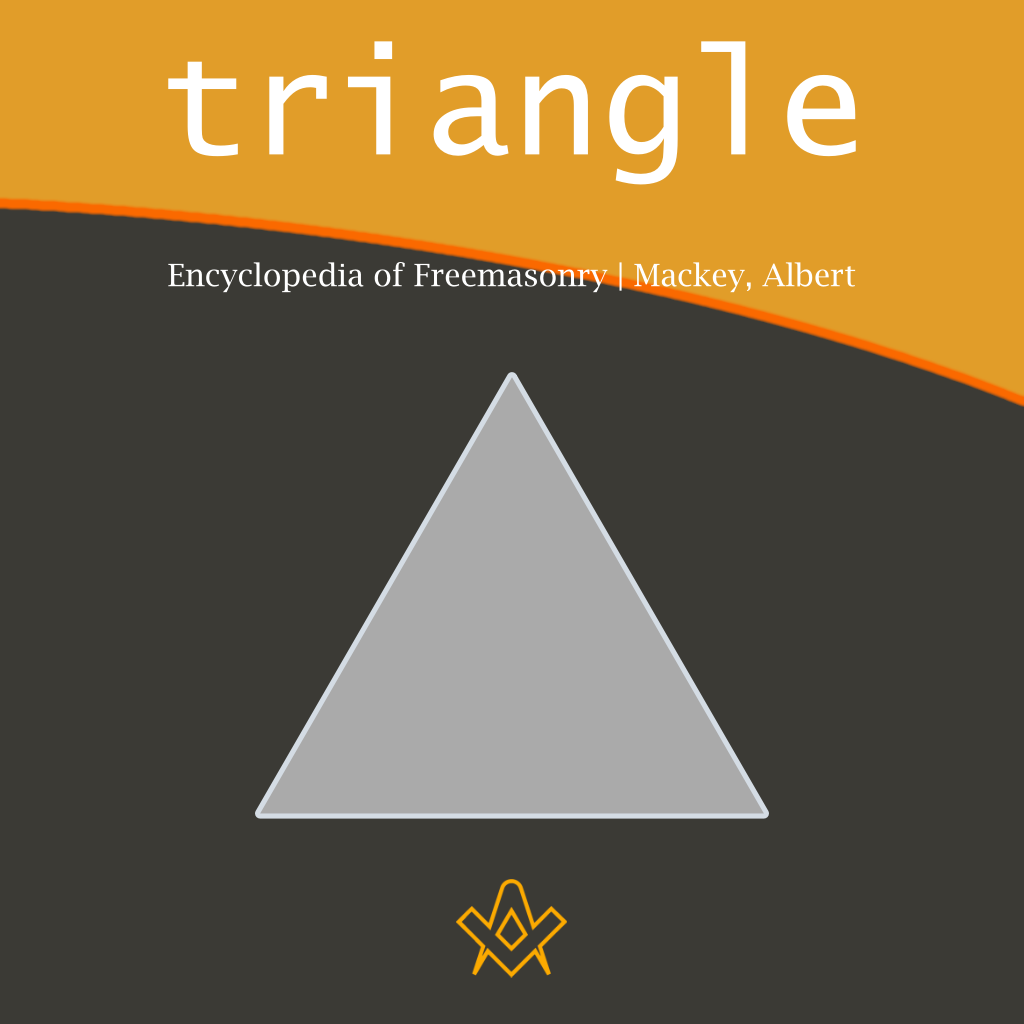There is no symbol more significant in its meaning, more versatile in its application, or more pervasive throughout the entire Freemasonry system than the triangle. Therefore, an examination of it cannot fail to be interesting to a Masonic student.
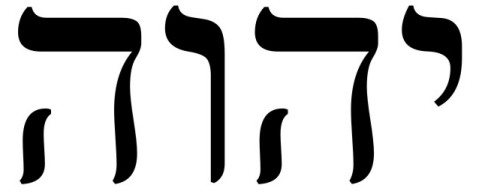
God’s name – YHVH (Tetragrammaton)
IMAGE LINKED: wikimedia Attribution 4.0 International (CC BY 4.0)
The equilateral triangle appears to have been adopted by nearly all ancient nations as a symbol of the Deity in some of his manifestations or emanations; consequently, it is likely that the prevailing influence of this symbol was carried into the Jewish system, where the yod within the triangle came to represent the Tetragrammaton, or sacred name of God.
According to Brother D. W. Nash (Freemasons Magazine iv, page 294), the equilateral triangle represents the Great First Cause, Creator and Container of all things, as one and indivisible, manifesting Himself in an infinite number of forms and attributes in this visible universe.
In Egyptian hieroglyphics, the trowel, an important Masonic tool, has the shape of a triangle, symbolising the darkness through which a candidate for initiation must pass.
They considered the equilateral triangle to be the most perfect of all figures and a symbol of the great principle of animated existence, with each of its three sides representing one of the three divisions of creation, the animal, vegetable, and mineral.
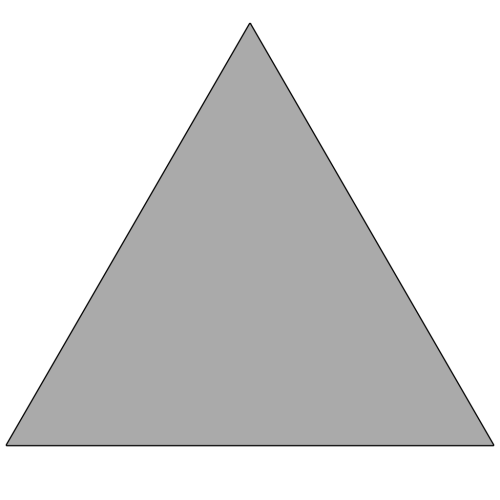
Masonic Symbol | The Triangle
The triangle of equilateral sides is prevalent throughout the Masonic system. It forms the figure that suspends the jewels of the officers within the Royal Arch.
In the Ineffable Degrees, the sacred Delta manifests everywhere as the emblem of the Grand Architect of the Universe.
Constantly exhibited in Ancient Craft Masonry as a component of significant ceremonies. The seats of the principal officers are arranged in a triangular formation, the positions of the three Lesser Lights are identical, and the Square and Compasses form, by their union on the Greater Light, two intersecting triangles with common bases.
The equilateral triangle is one of the most consistent forms of Masonic symbolism, to put it succinctly.
This figure also exists in the form of a triangle with a right angle, which merits consideration. The base represented Osiris or the male principle, the perpendicular represented Isis or the female principle, and the hypotenuse represented Horus, their son or the product of the male and female principles.
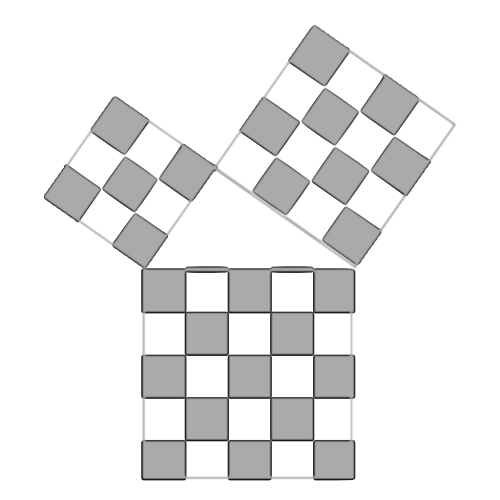
Pythagoras received this symbol from the Egyptians during his long sojourn in that country, and with it he learned its unique property, namely, that the sum of the squares of the two shorter sides is equal to the square of the longest side.
This property is symbolically expressed by the formula that Osiris and Isis are the parents of Horus. This figure has been adopted in the Third Degree of Freemasonry and will be acknowledged there as the Forty-seventh Problem of Euclid.
SQUARE AND TRIANGLE
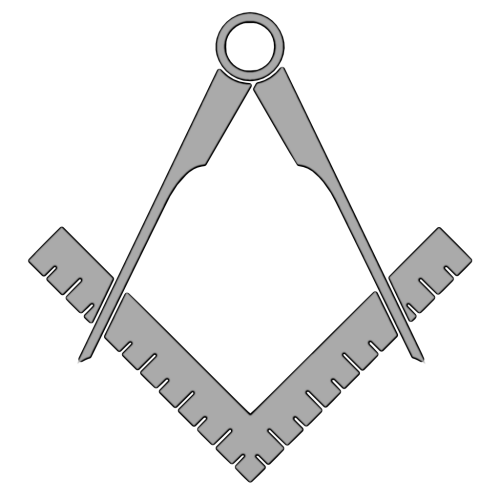
It is a type of the Eternal, the All-Powerful, and the Self-Existent. As the Delta was the initial letter of Deity in ancient cultures, so is its modern equivalent a type of the Eternal, the All-Powerful, and the Self-Existent.
As passive matter, the Square represents the material world, in contrast to the Triangle’s representation of force.
The Square is also a symbol of humanity, similar to how the Delta or Triangle represents God. The delta, Triangle, and Compasses are equivalent in nature.
The raising of one point, followed by another, denotes that the divine or higher portion of our nature should gain strength and control the baser tendencies.
This is the actual, practical “journey to the End.” The interlocking Triangles or Deltas represent the union of the active and passive, male and female forces that pervade the universe.
The interlacing of the two Triangles, one white and one black, symbolises the coexistence of the two apparent powers in nature, darkness and light, error and truth, ignorance and wisdom, evil and good, throughout a person’s life.
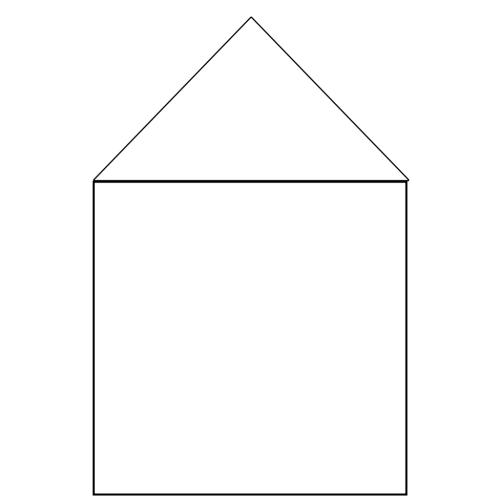
The Triangle and Square form the Pyramid as depicted on the Apron of an Apprentice-in-Training. In this context, the Pyramid represents matter and force units, as well as the unity of man and God. The placement of the numbers 3, 5, 7, and 9 in the parts and points of the Square and Triangle in pyramidal form signifies Perfection (see Pointed Cubical Stone and Broached Thurnel).
RADIATED TRIANGLE
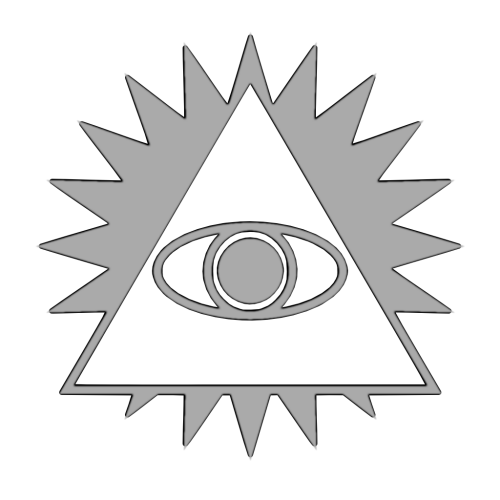
A triangle positioned within and encircled by a circle of rays. In Christian art, this circle is referred to as a Glory.
When this Glory surrounds the Triangle in the form of a circle, it becomes a representation of God’s eternal glory.
This is the typical usage in religious contexts. But when, as is typical in the Masonic symbol, the rays emanate from the centre of the Triangle and envelop it in their brilliance, it represents the Divine Light.
These rays of light were associated by the perverted beliefs of the Pagans with their sun-god and their Sabian worship.
But the true Masonic meaning of this Glory is that it represents the Eternal Light of Wisdom that surrounds the Supreme Architect as a Sea of Glory and emanates from Him as the centre of His created universe.
TRIANGLE, TRIPLE
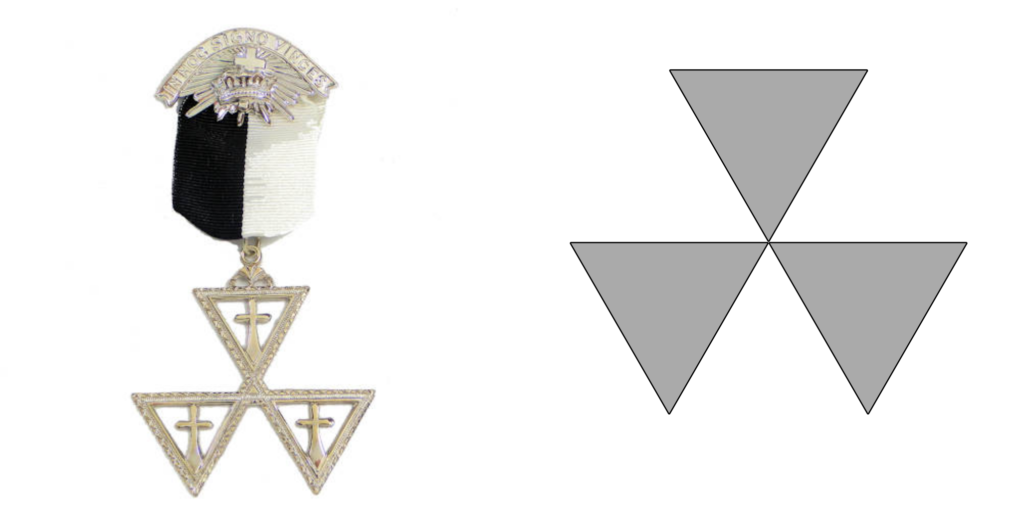
The perdalpha, or Triangle of Pythagoras, is commonly referred to as the Triple Triangle because the intersection of its sides forms three triangles.
However, there is another variety of the Triple Triangle that is more deserving of the name, as depicted in the illustration.
It will be recognisable to the Knight Templar as the shape of the jewel worn by his Order’s Prelate.
As with all variations of the triangle, it is a symbol of the Deity; however, as the Knights Templar Degree is exclusive to Christian Freemasonry, the Triple Triangle there refers to the Mystery of the Trinity.
In the Ancient and Accepted Scottish Rite Degree of Knight of the East, the symbol is also said to refer to the triple essence of Deity.
However, the symbolism is made even more enigmatic by assuming that it represents the sacred number 81, with each side of the three triangles equalling 9, which is the square of 3, the most sacred number in Freemasonry.
In the Twentieth Degree of the Ancient and Accepted Scottish Rite, or that of “Grand Master of all Symbolic Lodges,” the number 81 is said to refer to the triple covenant of God, symbolised by a Triple Triangle said to have been seen by King Solomon when he consecrated the Temple.
In fact, the triple triangle is referenced much more frequently in the Ineffable and Philosophical Degrees than in Ancient Craft Masonry.
The Hindu Triple Triangle, also known as the Indian Trimourti, has a unique shape consisting of three concentric triangles. In the middle is the holy triliteral name Aum.
The inner triangle represents Brahma, Vishnu, and Siva; the middle triangle represents Creation, Preservation, and Destruction; and the outer triangle represents Earth, Water, and Air.
Article by: Albert G. Mackey
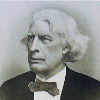
Albert Gallatin Mackey (1807 – 1881) was an American medical doctor and author.
He is best known for his books and articles about freemasonry, particularly the Masonic Landmarks.
In 1849 he established The Southern and Western Masonic Miscellany, a weekly masonic magazine.
He served as Grand Lecturer and Grand Secretary of The Grand Lodge of South Carolina, as well as Secretary General of the Supreme Council of the Ancient and Accepted Scottish Rite for the Southern Jurisdiction of the United States

ENCYCLOPEDIA OF FREEMASONRY
Vol 1
By: Albert Mackey
And its Kindred Sciences Comprising the Whole Range of Arts, Sciences and Literature as Connected With the Institution.
Mackey knew that very few men have the means, time, and the inclination for the purchase of numerous books, and for the close and attentive reading of them…to acquire a knowledge of all matters connected with the science, the philosophy, and the history of his Order.
It was this thought that suggested to him that he should collect materials for a work which under one cover might help to enlighten his Brethren.
This book is so absorbing you could sit and read it from cover to cover. It also serves as a handy reference guide for any Masonic question that may arise.
Highly recommended.
Recent Articles: symbolism
 Legends and Symbols in Masonic Instruction Explore the significance of Masonic legends and symbols in this insightful post. Discover how Freemasonry imparts wisdom through allegorical narratives and emblematic imagery, revealing profound moral and philosophical lessons. Unveil the deep connections between Masonic teachings and the broader quest for understanding life’s fundamental questions. |
 Discover the mystical significance of the number 33. From its mathematical marvels and artistic influence in numerology to its esteemed place in Freemasonry, delve into the history and power of this master number. Explore why 33 holds such profound meaning in various spiritual and philosophical traditions. |
 The Practice of Freemasonry - P1 Embark on a transformative journey with Freemasonry, where the exploration of your Center unlocks the Perfect Ashlar within. Through the practices of Brotherly Love, Relief, Truth, and Cardinal Virtues, discover a path of enlightenment and self-improvement. Embrace the universal creed that binds us in the pursuit of our true essence. |
 Discover the fascinating history and significance of the Warrant of Constitution within Freemasonry. Unveil the evolution of this crucial authorization, its role in legitimizing Lodges, and its lasting impact on the global brotherhood of Freemasons. Explore the intricate link it provides between tradition and modern practice. |
 Freemasonry: Unravelling the Complexity of an Influential Organization Mysterious and captivating, Freemasonry has piqued the interest of seekers and skeptics alike. With its intricate blend of politics, esotericism, science, and religion, this enigmatic organization has left an indelible mark on society. Prepare to delve into the secrets of Freemasonry and unlock its hidden depths. |
 Unlocking the Mysteries of Freemasonry: In the hallowed halls of Freemasonry, a powerful symbol lies at the heart of ancient rituals and teachings—the Volume of the Sacred Law. This sacred book not only guides the spiritual and moral journey of Freemasons but also serves as a beacon of universal wisdom and enlightenment. |
 The Ancient Liberal Arts in Freemasonry Embark on a journey of self-improvement and wisdom with Freemasonry's guiding principles. Ascend the winding stairs of moral cultivation, analytical reasoning, and philosophical understanding. Embrace arithmetic's mystical properties and geometry's universal truths. Let the harmony of the universe inspire unity and growth. Discover the profound, hidden knowledge in Freemasonry's path to enlightenment. |
 Initiation rituals around the world are filled with fascinating elements and different images. One of them is that of darkness. When societies speak of darkness, they often mean a lack of knowledge, a lack of choice, or a symbol of evil. During initiation rituals, darkness is used to represent the initiate's lack of knowledge about the world, society, and initiation in general. It can also represent the initiate's inability to make a choice or endure a situation. Whether you have participated in an initiation rite or not, the meaning of darkness remains an intriguing concept worth exploring. Initiation rituals around the world are filled with fascinating elements and different images. One of them is that of darkness. When societies speak of darkness, they often mean a lack of knowledge, a lack of choice, or a symbol of evil. During initiation rituals, darkness is used to represent the initiate's lack of knowledge about the world, society, and initiation in general. It can also represent the initiate's inability to make a choice or endure a situation. Whether you have participated in an initiation rite or not, the meaning of darkness remains an intriguing concept worth exploring. |
 Masonic Deacon rods potentially trace their origins to Greek antiquity, symbolically linked to Hermes' caduceus. As Hermes bridged gods and mortals with messages, so do Masonic Deacons within the lodge, reinforcing their roles through ancient emblems. This connection underscores a profound narrative, weaving the fabric of Masonic rites with the threads of mythological heritage, suggesting the rods are not mere tools but bearers of deeper, sacred meanings that resonate with the guardianship and communicative essence of their divine counterpart, Hermes, reflecting a timeless lineage from myth to Masonic tradition. |
 The biblical pillars erected by Solomon at the Temple's porch, hold a profound place in history. These brass behemoths are not mere decorations; they are symbols of strength, establishment, and divine guidance. Explore their fascinating construction, dimensions, and the deep meanings they carry in both biblical and Masonic contexts. |
 Unlocking the Mind's Potential: Dive deep into ground breaking research revealing how simple daily habits can supercharge cognitive abilities. Discover the untapped power within and redefine your limits. Join us on this enlightening journey and transform your world! |
 Dive deep into the symbolic importance of the trowel in Masonry, representing unity and brotherly love. From its historical roots in operative masonry to its significance in speculative masonry, this article explores the trowel's multifaceted role. Discover its connection to the sword, the story of Nehemiah, and the Society of the Trowel in Renaissance Florence. Unravel the layers of meaning behind this enduring Masonic symbol. |
 Symbolism of The Builder's Jewel Batty Langley's "The Builder’s Jewel" (1741) is a visual masterpiece of Masonic symbolism, showcasing Langley's deep understanding of Freemasonry. The frontispiece highlights key symbols like the three pillars and the legend of Hiram Abiff, emphasizing Langley's dedication to Masonic traditions and teachings. |
 Unveil the mystique of the colour blue in Masonic symbolism. A hue evoking universal friendship and benevolence, its roots span ancient cultures, infusing Freemasonry's core values. This article explores blue's profound significance, guiding Freemasons towards wisdom and spiritual enlightenment. Discover the fascinating journey of this universal symbol. |
 Discover the intriguing world of the plumb in Masonic symbolism with our in-depth analysis. Uncover its rich history, moral teachings, and significance in Freemasonry, guiding members on their path to truth, integrity, and justice. Immerse yourself in the captivating power of this symbol that shapes lives within the brotherhood. |
 Unlock the mysteries of Freemasonry with 'The Key,' a profound Masonic symbol. This seemingly simple instrument holds a deeper meaning, teaching virtues of silence and integrity. Explore its ancient roots, from Sophocles to the mysteries of Isis, and discover how it symbolizes the opening of the heart for judgment. |
 Unlock the secrets of the Freemasonry with The Blazing Star - a symbol that holds immense significance in their rituals and practices. Delve into its history, meaning and role in the different degrees of Freemasonry with expert insights from the Encyclopedia of Freemasonry by Albert Mackey. Discover the mystique of The Blazing Star today! |
 There is no symbol more significant in its meaning, more versatile in its application, or more pervasive throughout the entire Freemasonry system than the triangle. Therefore, an examination of it cannot fail to be interesting to a Masonic student. Extract from Encyclopedia of Freemasonry by Albert Mackey |
 The Hiramic Legend and the Myth of Osiris Hiram Abiff, the chief architect of Solomon’s Temple, is a figure of great importance to Craft Freemasonry, as its legend serves as the foundation of the Third Degree or that of a Master Mason. He is the central figure of an allegory that has the role of teaching the Initiate valuable alchemical lessons. Although his legend is anchored in biblical times, it may have much older roots. |
 This rite of investiture, or the placing upon the aspirant some garment, as an indication of his appropriate preparation for the ceremonies in which he was about to engage, prevailed in all the ancient initiations. Extract from The Symbolism of Freemasonry by Albert G. Mackey |
 The All-Seeing Eye of God, also known as the Eye of Providence, is a representation of the divine providence in which the eye of God watches over humanity. It frequently portrays an eye that is enclosed in a triangle and surrounded by rays of light or splendour. |
 What's in a Word, Sign or Token? Why do Freemasons use passwords, signs, and tokens? As Freemasons we know and understand the passwords, signs and tokens (including grips), which are all used a mode of recognition between members of the fraternity. |
 A Temple of Living Stones: Examining the Concept of a Chain of Union What are the origins of the Chain of Union? And how did they come about ? The answers may surprise some members as W Brother Andrew Hammer investigates, author of Observing the Craft: The Pursuit of Excellence in Masonic Labour and Observance. |
 One of the best loved stories for the festive season is ‘A Christmas Carol’. A traditional ghost story for retelling around the fire on a cold Christmas Eve, it is a timeless classic beloved by those from all walks of life. Philippa explores the masonic allegory connections… |
 The Trowel - Working Tool of the Master Mason The Trowel is the symbol of that which has power to bind men together – the cement is brotherhood and fellowship. |
 Two Perpendicular Parallel Lines The point within a circle embordered by two perpendicular parallel lines, with the Holy Bible resting on the circle, is one of the most recognizable symbols in Freemasonry. It is also one which always raises a question. How can two lines be both perpendicular and parallel? |
 "The first great duty, not only of every lodge, but of every Mason, is to see that the landmarks of the Order shall never be impaired." — Albert Mackey (1856) |
 It is common knowledge that the ancient wages of a Fellowcraft Mason consisted of corn, wine, and oil. |
 “Do not come any closer,” God said. “Take off your sandals, for the place where you are standing is holy ground.” Exodus 3:5 |
 The Secret Language of the Stone Masons We know of Masons' Marks but lesser known are the 'argots' used by the artisans - in part 2 of a series on the social history of the Operative Masons we learn how the use of secret languages added to the mystery of the Guilds. |
 The phrase appears in the Regius Poem. It is customary in contemporary English to end prayers with a hearty “Amen,” a word meaning “So be it.” It is a Latin word derived from the Hebrew word - Short Talk Bulletin - Vol. V June, 1927, No.6 |
 Egypt's 'Place of Truth' - The First Operative Stone Masons' Guild? Was ancient Egypt's 'village of the artisans' the first operative stone masons' guild? And was their use of 'identity marks' a forerunner of the Mason's Marks of the cathedral builders of the Middle Ages? Read on for some possible answers… |
 The Pieces of Architecture and the Origin of Masonic Study Discover the journey of the Apprentice – from Operative to Speculative. This journey has been carried out since the times of operative Freemasonry but today the initiate works in the construction of his inner temple. |
 The Builders' Rites - laying the foundations operatively and speculatively The cornerstone (also ‘foundation’ or ‘setting’ stone) is the first stone to be set in the construction of the foundations of a building; every other stone is set in reference to this. |
 Applying the working tools to achieve our peculiar system of morality. |
 We take an in-depth look at the 47th Proposition of the 1st Book of Euclid as part of the jewel of the Past Master. |
 The Cable Tow: Its Origins, Symbolism, & Significance for Freemasons - Unbinding the significance of the cable tow. |
 We examine at one of the most impressive moments of the initiatory ceremony, a certain rite known as Circumambulation, and ask what is its meaning and purpose ? |
 So, what is the Level? And why do we use it in Freemasonry? |
 What is the mysterious pigpen or Masonic cipher that has been used for centuries to hide secrets and rituals? |
 The Story of the Royal Arch - The Mark Degree Extracted from William Harvey's 'The Story of the Royal Arch' - Part 1 describes the Mark Degree, including the Working Tools. |
 Ashlars - Rough, Smooth - Story of a Stone How we can apply the rough and smooth Ashlars with-in a masonic context |
 A detailed look at the Chamber of Reflection: A Revitalized and Misunderstood Masonic Practice. |
 Exploring the origin and symbolism of Faith, Hope and Charity |
 The Noachite Legend and the Craft What is it to be a true Noachidae, and what is the Noachite Legend and the Craft ? |
 In Masonic rituals, Jacob’s ladder is understood as a stairway, a passage from this world to the Heavens. |
 What is the meaning of the Acacia and where did it originate ? |
 What is the connection with the Feasts of St John and Freemasonry |
 The Forget-Me-Not and the Poppy - two symbols to remind us to 'never forget' those who died during the two World Wars. |
 Biblical history surrounding the two pillars that stood at the entrance to King Solomon's Temple |
 Is there a direct link between Judaism and Freemasonry? |
 The symbolism of the beehive in Masonry and its association with omphalos stones and the sacred feminine. |
 The Wages of an Entered Apprentice |
 An explanation of the North East corner charge which explores beyond one meaning Charity - |
 A brief look at the origins of the two headed eagle, probably the most ornamental and most ostentatious feature of the Supreme Council 33rd Degree Ancient and Accepted (Scottish ) Rite |
 A Muslim is reminded of his universal duties just as a Freemason. A Masonic Interpretation of the Quran's First Two Chapters |
 The three Latin words -{Listen, Observe, Be Silent}. A good moto for the wise freemason |
masonic knowledge
to be a better citizen of the world
share the square with two brothers

click image to open email app on mobile device


